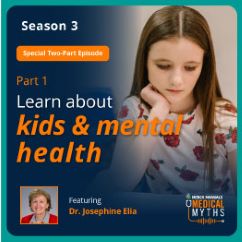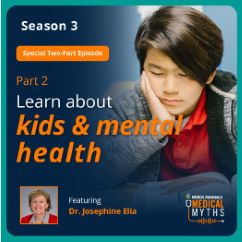- Overview of Mental Health Disorders Children and Adolescents
- Overview of Anxiety Disorders in Children and Adolescents
- Acute and Posttraumatic Stress Disorders in Children and Adolescents
- Agoraphobia in Children and Adolescents
- Bipolar Disorder in Children and Adolescents
- Conduct Disorder
- Depression and Mood Dysregulation Disorder in Children and Adolescents
- Generalized Anxiety Disorder in Children
- Nonsuicidal Self-Injury in Children and Adolescents
- Obsessive-Compulsive Disorder (OCD) and Related Disorders in Children and Adolescents
- Oppositional Defiant Disorder
- Panic Disorder in Children and Adolescents
- Schizophrenia in Children and Adolescents
- Separation Anxiety Disorder
- Social Anxiety Disorder in Children and Adolescents
- Somatic Symptom and Related Disorders in Children
- Suicidal Behavior in Children and Adolescents
Anxiety disorders are characterized by fear, worry, or dread that greatly impairs the ability to function and is out of proportion to the circumstances.
There are many types of anxiety disorders, distinguished by their primary focus on fear, worry, or dread.
Most commonly, children refuse to go to school, often using physical symptoms, such as a stomachache, as the reason.
Doctors usually base the diagnosis on symptoms but sometimes do tests to rule out disorders that could produce the physical symptoms often caused by anxiety.
Behavioral therapy is often sufficient, but if anxiety is severe, medications may be needed.
(See also Overview of Anxiety Disorders in adults.)
All children feel some anxiety sometimes. For example, 3- and 4-year-olds are often afraid of the dark or monsters. Older children and adolescents often become anxious when giving a book report in front of their classmates. Such fears and anxieties are not signs of a disorder. However, if children become so anxious that they cannot function or become greatly distressed, they may have an anxiety disorder. Studies show that about 3% of 6-year-olds, 5% of adolescent boys, and 10% of adolescent girls have anxiety disorders. Children with an anxiety disorder are at increased risk of depression, suicidal behavior, alcohol and substance use disorders, and academic difficulties later in life.
People can inherit a tendency to be anxious. Anxious parents tend to have anxious children.
Anxiety disorders include
During the COVID-19 pandemic, anxiety symptoms in young people doubled, especially in girls. Mental health visits for anxiety also increased. After controlling for gender, age, and pre-COVID anxiety symptoms, the following were found to be significant predictors of COVID-19 anxiety symptoms in children:
Poor connectedness to caregiver
Sleep problems
High amounts of screen time
Symptoms
Many children with an anxiety disorder refuse to go to school. They may have separation anxiety, social anxiety, or panic disorder or a combination.
Some children talk specifically about their anxiety. For example, they may say “I am worried that I will never see you again” (separation anxiety) or “I am worried the kids will laugh at me” (social anxiety disorder). However, most children complain of physical symptoms, such as a stomachache. These children are often telling the truth because anxiety often causes an upset stomach, nausea, headaches, and sleep problems in children.
Many children who have an anxiety disorder struggle with anxiety into adulthood. However, with early treatment, many children learn how to control their anxiety.
Diagnosis
A visit with a doctor or behavioral health specialist
Sometimes questionnaires about symptoms
Sometimes observing the child's behavior
Tests to check for other causes of symptoms
Doctors usually diagnose an anxiety disorder when the child or parents describe typical symptoms. The doctor will also talk with the child and may observe the child's activities or ask the child or parents to fill out a specialized questionnaire.
Some symptoms that anxiety can cause may also be caused by a medical issue, and doctors may do tests for physical disorders before an anxiety disorder is considered.
Treatment
Behavioral therapy
Sometimes medications
If anxiety is mild, behavioral therapy alone is usually all that is needed.
One form of therapy that is often effective is called cognitive-behavioral therapy (CBT). CBT is a short-term, structured form of talk therapy designed to help people identify and then challenge negative thought patterns so that they can deal with difficult situations more effectively.
Another approach is called exposure therapy. Therapists expose children to the situation that triggers anxiety and help the children remain in the situation and feel comfortable. Thus, children gradually become desensitized and feel less anxiety. When appropriate, treating anxiety in parents at the same time often helps.
If anxiety is severe, medications may be used. A type of antidepressant called a selective serotonin reuptake inhibitor (SSRI), such as fluoxetine or sertraline, is usually the first choice if drug treatment is needed for a long time. Most children can take SSRIs without any problem. However, some children have an upset stomach, diarrhea, or insomnia or gain weight. A few become restless or more impulsive. There has been concern that antidepressants may cause a slight increase in the risk of suicidal thinking in children and adolescents (see (SSRI), such as fluoxetine or sertraline, is usually the first choice if drug treatment is needed for a long time. Most children can take SSRIs without any problem. However, some children have an upset stomach, diarrhea, or insomnia or gain weight. A few become restless or more impulsive. There has been concern that antidepressants may cause a slight increase in the risk of suicidal thinking in children and adolescents (seeAntidepressant drugs and suicide).
If drug treatment is needed only for a short time (for example, because a child is very anxious before a medical procedure), benzodiazepines, a type of sedative, are usually used.



